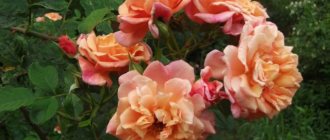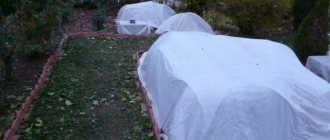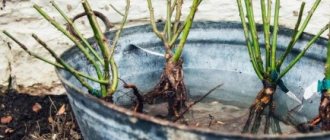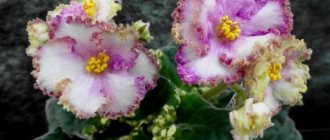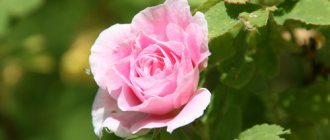The Rococo rose is a real work of art: fragile, delicate, a beautiful apricot shade, it seems to have stepped out of the paintings of medieval artists. Many consider this particular variety to be the real queen of roses. The Rococo rose looks great both in the garden and in a bouquet, and can decorate any landscape. Let's get acquainted with the characteristics of this plant, find out how to care for it and in what conditions to maintain it.
Origin
The birthplace of this gorgeous plant is Germany. In 1987, the German breeder Tantau introduced a new scrub - the Rococo rose. When developing a new variety, he managed to preserve and express the splendor of the tones and shapes of old roses. For this reason, the rose is included in the “Nostalgic Dreams” series.
The climbing rose should not be confused with the Rococo bush rose. The second is rugosa, the “parent” of which is the wrinkled rose hip, and it is not tall. The rose in question is considered the best and is used to decorate arches and arbors.
Description of the Rococo rose
The climbing plant can be found in recreation areas. The rose has an aristocratic and rather rich appearance. It has such charm because of its pastel color and abundance of flowering. Through the foliage you can see how flexible but strong shoots tightly wrap around their base. They reach a height of 180 cm and a width of 1 meter.
Rose "Rococo" can be called a "mystery", as its colors vary from milky pink to apricot tones. Moreover, this manifests itself on one inflorescence. If you take a closer look at each individual flower, it becomes clear why the rose looks so lush. Terry petals overlap each other in waves, leaving open space for a wonderful center. All these beautiful features are clearly visible in the photo of the Rococo rose.
Flowering occurs in two waves and the bulk of the flowers are released in the first. And this is natural, because the plant releases the energy and minerals that have accumulated in it. The flowering period lasts from June until autumn. Each inflorescence has 3 large buds. Unfortunately, blooming roses wither after 5 days and become too faded. But new flowers come to the rescue, opening every day.
The leaves of the Rococo rose are sparsely spaced. Their glossy surface and rich green color give the bush a decorative appearance. Rose has a distinct aroma.
When ordering a seedling, you need to pay attention to the fact that its root is packed in a wet peat mixture and wrapped in film. Thanks to this, he will be delivered alive and will settle down perfectly in his new place. If, when purchasing a rose, the bush is filled with wax, then there is no need to remove it.
Decorative advantages of a modern aristocrat
The “Rococo” variety rose is classified as a bush rose-scrub of medium height: a beauty with nostalgic charm, depending on the conditions, will reach from 120 to 150 cm. This is a modern, but looks like an ancient variety thanks to the nostalgic shape of the flowers. The rose was obtained in 1987 and belongs to the Tantau selection; today it is considered one of the best German varieties. "Rococo" is a cut rose that blooms profusely and for a long time.
Silhouette and foliage
What gives the plant a special charm is the shape of the bush, tall, elegant and as if reaching upward: with sufficient height, the diameter will not exceed 1 meter. The rose has dense branches, is distinguished by a high crown density, impenetrable and massive, looking good both in a hedge and as a background plant. The shoots are characterized by an accelerated rate of ripening, very thick and strong. The foliage is discreetly glossy, dark, with a grayish-muted color tone, against which watercolor rose inflorescences seem to sparkle.
Flowering time
"Rococo" blooms at the very beginning of summer, but the period during which it produces almost tirelessly luxurious flowers will pleasantly surprise you. After all, this rose with an ancient appearance decorates gardens until October, when the first cold days of late autumn arrive. The flowers are resistant to rain, but gradually fade without losing their attractiveness.
Features of flowering
The large flowers of this variety are collected in clusters, reach 10 cm in diameter and do not fade for about 2 weeks. Even the buds of “Rococo” are beautiful: yellowish, only colored pink at the top, with a beautiful sharp tip; they seem too small against the background of the large flowers that have already bloomed. In “Rococo” they are terry, surprisingly picturesque, the slight waviness of the petals gives them a nostalgic charm. When the flowers fully open, the rose appears even more elegant thanks to the bright orange stamens. The aroma, although not strong, is very bright, unusual and fruity.
Rose "Rococo" (Rokoko). Huhu
Color spectrum
The palette of this rose only emphasizes its aristocracy. Delicate watercolor color with soft transitions of tone represents all the richness of light apricot and similar pink shades, which after the flower has fully bloomed become almost creamy. Closer to autumn, the color of the flowers becomes more and more pale.
This is interesting: Rosa Red piano
Features of the variety
- Frost resistance.
- Excellent immunity to diseases. The Rococo rose variety is especially resistant to black spot and powdery mildew.
- After rains, the plant does not lose its appearance.
- One of the main features is that roses bloom all season.
- The length of the branches is an important criterion for those who decorate flower beds.
Regarding the choice of location, planting and care, the rose does not have any differences from other climbing varieties.
Some original chicken coop ideas
Two in one: for those who have a desire for housekeeping. | Photo: hr.bestuserschoice.com/pinterest.com.
From “gothic” to rustic originality. | Photo: secondstreet.ru/make-self.net.
Luxurious mansions for chickens. | Photo: hr.bestuserschoice.com/happymodern.ru.
In these chicken coops, the owners realized their dream of having a treehouse. | Photo: happymodern.ru/1dacha-sad.com.
Looking at such a chicken coop, there is an irresistible desire to live in it yourself. | Photo: make-self.net.
These houses are not inhabited by hobbits, but by chickens of creative homeowners. | Photo: pikabu.ru/landshaftdizajn.ru.
Selecting a location
Ideally, it is better to plant the Rococo climbing rose in parks or in garden plots where trees grow nearby. It is important to consider at what time of day the shadow will fall on the rose. In the morning, the queen of the garden needs the sun to dry the dew on her, which in turn will protect her from fungal diseases. At midday, rose bushes may benefit from nearby bushes. Under this cover, the delicate plant will not get sunburned. If you plan to plant roses near buildings or other tall objects, then the distance should be 1 meter. Bushes should be planted on the south side. A strip of land of 50 cm will be quite enough for the normal development of the plant.
Diseases, pests and ways to combat them
With buds blooming in the spring, rose bushes become very vulnerable to diseases and pests. For prevention, they are treated sequentially with an interval of 7-10 days:
- Bordeaux mixture or HOM. Helps strengthen the bush’s immunity to fungal diseases;
- fitoverm. Spraying is carried out against all groups of rose pests.
Caring for Rococo coincides with standard agricultural techniques for hybrid tea varieties. This rose is recommended for those who already have some experience in growing. But even a beginner can achieve lush flowering if he manages to purchase high-quality planting material.
Soil preparation
Rose Rococo is more suitable for loamy soil. If the soil is too heavy, it is diluted with sand during digging. Clay is added to sandy soil. The application of humus and phosphorus fertilizers is mandatory. To create the necessary balance in the soil, the listed actions must be carried out first. 2 weeks before planting, you need to dig holes and fill them with water.
The presence of groundwater should be taken into account, because the roots of climbing roses go deep into the lower layers of the soil. If the waters lie close, in such cases the plants are placed on a slope so that the root system does not retain water.
Growing conditions
Let's find out where it is better to plant a Rococo rose and what conditions the plant needs to be provided.
Description of the place
It is recommended to plant this variety in a sunny place that is well lit throughout the day. It is in such conditions that the rose will be able to demonstrate all its amazing decorativeness. You can’t plant it in the shade: the buds will be small and the flowering period will be short.
It is not worth growing the flower even in light partial shade, not to mention significantly shaded areas. The more open and sunny the place, the more decorative Rococo will delight you.
It is strictly not recommended to plant this variety in lowlands with stagnant soil: such conditions lead to root rot and plant diseases.
It is forbidden to plant the plant in a flowerbed where other roses have previously grown. Plants may have common infections and pests that are likely to persist in the soil.
Temperature
Rose Rococo should be grown in a warm place: this variety is not suitable for the northern regions, except for greenhouses and hothouses. For the winter, the bush must be covered.
Humidity
The Rokoko rose feels best when the air humidity is slightly above average. The plant does not tolerate drafts: make sure that the bush is protected from the north by a wall or fence.
Soil composition and structure
Rose prefers loamy soil, moisture-absorbing and with good drainage properties. Sandy loam soil will also work, provided it is sufficiently fertile and drainable. The soil in the garden bed is dug up, loosened, then nutrients are added to it, and only then holes for planting are formed.
Selection of seedlings
In nurseries, seedlings of this rose are usually sold with closed roots. This means that the roots of the plant are “hidden” in a layer of soil protected by paper and polyethylene. Before placing the seedling in the ground, the polyethylene and the tube on top are removed, and the paper is left.
Saplings with an open root system are sold much less often. In this case, close attention should be paid to the roots: they should have an even light shade, not be damaged or weak. Rot and dark spots on the roots are unacceptable.
Inspect the plant itself: at least three shoots should extend from the trunk. This is the key to future good branching of the rose.
Landing Features
It is recommended to choose spring for planting this rose: May is optimal. It is this period of time that is recommended by the breeding company and manufacturers of planting material. However, if the climate is warm, planting can be done in the fall.
If several bushes are planted, do not forget to leave a distance of at least 1.5-2 meters between them. It is unacceptable to thicken the plantings, as this will lead to frequent fungal diseases in the future.
A seedling with an open root system is placed in a hole and the roots must be straightened along the bottom. If the system is closed, then the plant is rooted directly with the “native” earthen lump. The root collar or graft should be located 3-5 cm below the ground level.
After planting, it is recommended to mulch the root zone along its diameter. The measure will protect the roots from drying out and rid the bed of weeds.
Landing
In spring, roses are planted from the second half of April, and in autumn - from the end of September. Before planting, seedlings are soaked in water for 24 hours. Then carry out the following actions:
- Unsuccessful or broken shoots are cut off, and all leaves on the remaining ones are cut off. Bare areas are sprinkled with wood ash.
- The buds located below the grafted site are removed. If you ignore this operation, rose hips will begin to grow from below.
- For disinfection, seedlings are immersed in a solution of copper sulfate.
- Immediately before planting, the roots are dipped in mash prepared in this way: clay and water are thickly diluted to make a total of 10 liters; 1 tablet of “Heteroauxin” and 3 tablets of “Phosphorobacterin” are dissolved in a small amount of water and mixed with the total mass.
- When planting, the grafting site is deepened by 10 cm and the rose is watered generously.
- After the ground has subsided a little, you should hill up the bush to a depth of 20 cm.
Fruits and their properties
The main difference between the fruits of this variety and other lemons is their characteristic color. It is even reflected in the name - Red. The fact is that the color of Rosso’s peel is orange, often even reddish. The intensity of red color is directly related to the level of illumination. The more light exposed to the ripening fruit, the redder it turns out in the end.
Interesting! It has been noticed that the fruits are capable of acquiring a red color if they are picked and placed in the refrigerator.
The color of the flesh of this lemon is slightly orange. In combination with the red skin, this makes the sliced fruit very decorative, capable of decorating any dish on the table.
Other fruit features:
— The surface is rough, lumpy, citron-like. — The peel is thick, tough, but still thinner than that of citrons. — The shape is elongated, sometimes slightly pear-shaped, with a blunt nipple at the tip. — The sizes are small, usually from 100 to 160 grams. — The pulp is sweetish, juicy, there are either no seeds in it, or there are only small quantities. This fruit is considered one of the most delicious among lemons. — The peel has a pleasant, strong aroma. When dried, it is often used to flavor teas and other drinks.
Care
Like all climbing roses, the Rococo rose tolerates drought more easily than its bush “sisters”. However, it will look lively if watered twice a week.
After the first loosening, it would be a good idea to mulch the soil around the trunk with humus. This will save you from unnecessary weeding and walking around the flowerbed. You can use pine needles, sunflower husks and other materials as mulch. But this is the case if flowers are planted close to the rose bush, which will cover the mulching material.
In summer, the rose does not need feeding. This is usually done in the fall, along with pruning.
And finally, the most pleasant thing about caring for such a lovely plant is creating support. This is a reason for fantasy. There are plenty of possible options. Weaving bushes are used to create excellent hedges, or to spread lashes onto metal arches or dry trees. Grates installed along the walls look original; you can diversify their shapes.
Flower propagation
Roses from the Rococo bush series are not propagated by seed. If there is already a healthy bush on the site, a year after planting you can take cuttings from it for propagation.
For your information! The ideal time for cuttings is the first ten days of June. By this time, depending on the weather, there may already be buds at the ends of the shoots; they must be removed from the cuttings.
To obtain planting material, at the beginning of summer, shoots with 3 pairs of leaves are cut off, which can be rooted right there in the garden bed. Be sure to put a cap made from a cut plastic bottle on top. If rooting is successful, young bushes are planted in a permanent place at the end of May next spring.
Rooting rose cuttings
